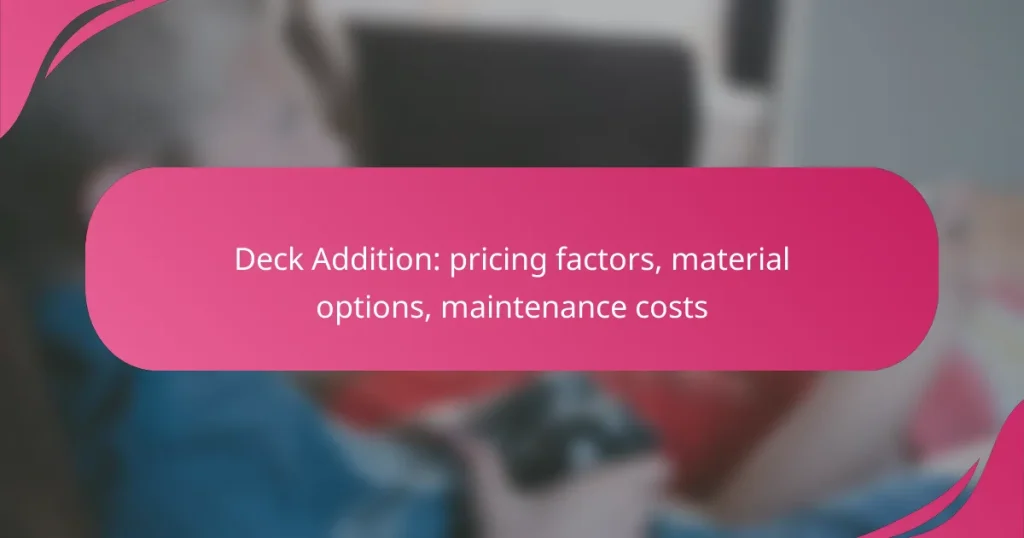When planning a deck addition, it’s crucial to consider various pricing factors such as material costs, labor expenses, and permit fees, which can significantly impact your budget. Homeowners can choose from a range of materials, including wood, composite, and aluminum, each with distinct advantages and maintenance requirements. Understanding these elements will help ensure a successful and cost-effective deck project that meets your needs.

What are the pricing factors for deck additions in Canada?
The pricing factors for deck additions in Canada include material costs, labor expenses, permit fees, design complexity, and location-specific costs. Understanding these elements can help homeowners budget effectively and make informed decisions about their deck projects.
Material costs
Material costs significantly impact the overall price of a deck addition. Common materials include pressure-treated wood, composite decking, and hardwoods, each with varying price points. For example, pressure-treated wood may range from CAD 15 to CAD 30 per square foot, while composite materials can cost between CAD 30 and CAD 60 per square foot.
When selecting materials, consider durability, maintenance requirements, and aesthetic preferences. Higher-quality materials may have a higher upfront cost but can lead to lower maintenance expenses over time.
Labor expenses
Labor expenses are another critical factor in the pricing of deck additions. Skilled labor can range from CAD 50 to CAD 100 per hour, depending on the complexity of the project and the region. Hiring experienced contractors may result in higher initial costs but can ensure quality workmanship and adherence to local building codes.
To manage labor costs, consider obtaining multiple quotes from contractors and discussing the scope of work in detail. This can help identify any potential savings without compromising quality.
Permit fees
Permit fees vary by municipality and are often required for deck additions. These fees can range from CAD 50 to CAD 500, depending on the size and complexity of the deck. It’s essential to check with local authorities to understand the specific requirements and costs associated with obtaining the necessary permits.
Failing to secure the appropriate permits can lead to fines or the need to dismantle the deck, making it crucial to factor these costs into your overall budget.
Design complexity
The complexity of the deck design can significantly influence the overall cost. Simple, rectangular decks are generally less expensive to build than multi-level or custom-shaped decks. Features such as built-in seating, railings, and lighting can also add to the complexity and cost.
When planning your deck, consider how the design will affect both the budget and the functionality of the space. A well-thought-out design can enhance the value of your property while staying within budget.
Location-specific costs
Location-specific costs can impact the pricing of deck additions due to regional labor rates, material availability, and local regulations. Urban areas may have higher labor costs compared to rural regions, while certain materials may be more readily available in specific locations, affecting pricing.
Additionally, factors such as local climate and soil conditions can influence the choice of materials and construction methods, further impacting costs. Researching local market conditions can help you make informed decisions and avoid unexpected expenses.

What material options are available for deck additions?
Deck additions can be constructed from various materials, each offering unique benefits and considerations. The most common options include wood, composite, aluminum, PVC, and pressure-treated lumber, each varying in cost, maintenance, and durability.
Wood decking
Wood decking is a traditional choice that provides a natural aesthetic and warmth. Common types include cedar, redwood, and pressure-treated pine, with costs typically ranging from moderate to high depending on the species and quality.
While wood decking can be beautiful, it requires regular maintenance such as sealing and staining to protect against weathering and pests. Without proper care, wood can warp, splinter, or decay over time.
Composite decking
Composite decking is made from a blend of wood fibers and plastic, offering a durable and low-maintenance alternative to wood. It is resistant to fading, staining, and mold, making it a popular choice for homeowners looking for longevity.
Although composite decking can be more expensive upfront compared to wood, its reduced maintenance needs can lead to cost savings over time. Expect prices to be in the mid to high range depending on the brand and features.
Aluminum decking
Aluminum decking is a lightweight and highly durable option that is resistant to rust, corrosion, and insects. It is ideal for areas with extreme weather conditions and can last for decades with minimal maintenance.
While aluminum decking tends to be one of the pricier options, its longevity and low upkeep can justify the initial investment. It is often available in various colors and finishes, allowing for customization.
PVC decking
PVC decking is made entirely from plastic, offering a waterproof and low-maintenance solution. It does not require staining or sealing and is resistant to fading, scratches, and mold.
This material is typically priced in the mid to high range, similar to composite options. Its lightweight nature and ease of installation make it a practical choice for many homeowners.
Pressure-treated lumber
Pressure-treated lumber is wood that has been chemically treated to resist rot, insects, and decay. It is one of the most affordable decking materials and is widely available, making it a popular choice for budget-conscious projects.
However, pressure-treated lumber requires regular maintenance, including sealing and staining, to prolong its lifespan. It is essential to follow local regulations regarding treatment chemicals, especially in residential areas.

What are the maintenance costs associated with deck additions?
The maintenance costs for deck additions can vary significantly based on materials, usage, and local climate. Regular upkeep is essential to prolong the life of your deck and can include cleaning, sealing, and repairs.
Cleaning and sealing
Cleaning and sealing are crucial for maintaining the appearance and longevity of your deck. Depending on the material, cleaning may involve pressure washing or using specific cleaners, typically costing between $100 and $300 annually. Sealing, which protects against moisture and UV damage, may need to be done every one to three years, with costs ranging from $200 to $600.
Repairs and replacements
Over time, decks may require repairs or replacements due to wear and tear. Common issues include loose boards, damaged railings, or rotting wood. Repair costs can vary widely, generally falling between $50 and $500, while full board replacements can run from $1,000 to $3,000 depending on the size and material of the deck.
Seasonal upkeep
Seasonal upkeep involves preparing your deck for changing weather conditions. In colder climates, this may include snow removal and applying anti-icing agents, while warmer areas might require regular inspections for sun damage. Budgeting around $100 to $200 each season can help cover these tasks and ensure your deck remains in good condition.
Long-term durability
The long-term durability of your deck significantly impacts maintenance costs. Composite materials generally require less maintenance than wood, which may need regular staining and sealing. Investing in higher-quality materials upfront can reduce overall maintenance costs over time, potentially saving hundreds to thousands of dollars in repairs and replacements. Consider the lifespan of materials: wood decks may last 10 to 15 years, while composite options can last 25 years or more with proper care.

What are the prerequisites for adding a deck in Canada?
To add a deck in Canada, homeowners must consider local building codes, obtain necessary permits, and ensure compliance with zoning regulations. These prerequisites help ensure safety and adherence to community standards.
Building permits
Obtaining a building permit is often the first step in adding a deck. This permit confirms that your project meets local safety and zoning regulations. The process typically involves submitting plans that detail the deck’s design, dimensions, and materials.
Permit requirements can vary significantly between provinces and municipalities. For instance, some areas may require a site plan showing the deck’s location relative to property lines, while others might have specific guidelines on height and materials.
Homeowners should check with their local building department to understand the exact requirements and fees associated with obtaining a permit. Failing to secure the necessary permits can result in fines or the need to dismantle the deck.


